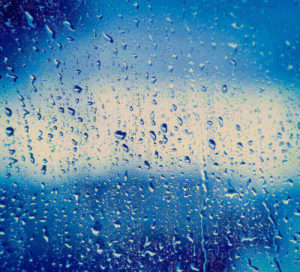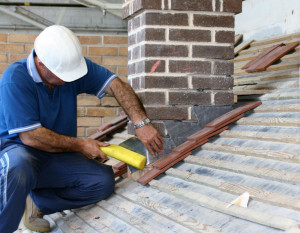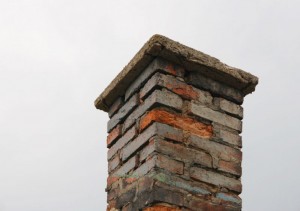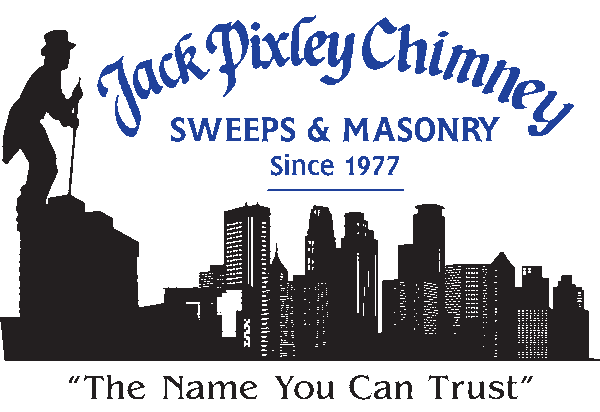Chimneys are designed to withstand mother nature’s worst. Unfortunately, overexposure to the elements can cause damage – particularly when regular maintenance and upkeep are not performed. However, homeowners have a number of options when it comes to extending the life of their chimneys. At Jack Pixley Sweeps, we are proud to use SaverSystems products. These products can help extend the life of your chimney by protecting it against water damage – and may even be able to stop existing damage from getting worse too.
SaverSystems products can save your chimney!
 If water has damaged the masonry of your chimney, SaverSystems products may be able to help. These waterproofing products are specially designed for use on chimney systems. Waterproofing the chimney can help prevent further damage and avoid expensive chimney repairs such as tuckpointing or chimney rebuild. Whether the bricks are beginning to crumble, the flashing has lost its seal, or the chimney crown has a crack, SaverSystems has a product to save your chimney!
If water has damaged the masonry of your chimney, SaverSystems products may be able to help. These waterproofing products are specially designed for use on chimney systems. Waterproofing the chimney can help prevent further damage and avoid expensive chimney repairs such as tuckpointing or chimney rebuild. Whether the bricks are beginning to crumble, the flashing has lost its seal, or the chimney crown has a crack, SaverSystems has a product to save your chimney!
- ChimneySaver: ChimneySaver is a penetrating, waterproofing product that is made to stop water penetration and prevent further damage to the freeze-thaw process. This product provides long-term protection against water damage, forming a strong bond with both masonry and concrete. When it is applied, it can penetrate as deep as ¼ inch in most areas of the chimney.
Because traditional paints and sealants are non-permeable, painting the chimney traps any existing water inside the bricks. When this occurs, damage under the surface can continue to take place. ChimneySaver is a vapor-permeable product, meaning that while it keeps water from rain, snow, and other sources of moisture out. It also allows any trapped water in your chimney to evaporate.
- CrownCoat: CrownCoat is a flexible, waterproof sealant that is designed to be applied to the chimney crown and chimney wash. The chimney crown is particularly vulnerable to water damage because of its location. Because it is a flat surface that seals the top of the chimney around the flue, the chimney crown is often exposed to significant amounts of water and pooling snow or rain.
For chimney crowns with minor damage or those that simply want to do preventative maintenance, CrownCoat is an easy and cost-effective way to prevent water damage. When it is applied by a chimney professional, it carries a 15-year guarantee against further water intrusion.
- FlashSeal: Flashing is the strips of metal and plastic that seal the joint between the chimney and roof. When incorrectly installed or damaged, leaky flashing can damage the chimney and the surrounding roof, walls, and ceilings. FlashSeal is a rubber membrane that can be applied over existing flashing to create a waterproof barrier. When it is applied with reinforcement fabric, FlashSeal is guaranteed to last seven years.
Don’t let water ruin the bricks and mortar of your chimney. Instead, keep your entire system looking beautiful for years to come with SaverSystems waterproofing products. For more information about waterproofing your chimney or SaverSystems products, contact Jack Pixley Sweeps today!
While water in the fireplace can be easily cleaned up, it should never be ignored. Chimney leaks, even minor ones, can cause serious damage throughout your fireplace system.
Signs of a Chimney Leak
While chimney leaks are often discovered by the presence of water in the firebox, there are a number of other signs that water entry may be affecting your chimney. The following are just a few of the signs of a chimney leak.
- Moisture, dampness, or water in the firebox
- Rust on the damper
- Masonry spalling
- Sounds of dripping inside the chimney
What Causes a Chimney Leak?
Because chimneys are complex structures there are a number of ways that water can get into the chimney system. The following are three of the most common areas where water can enter your chimney.
- Chimney cap. A chimney cap is a metal top with mesh sides that protects the top of the flue from animal, debris, and water entry. A damaged, sized or incorrectly installed chimney cap allows water into the unprotected chimney.
- Chimney crown. Made of stone or cement, the chimney crown is a slab that covers and seals the top of the chimney. Because of their location, chimney crowns are prone to overexposure to the elements; chips and cracks from repeated exposure can create chimney leaks.
- Chimney flashing. Flashing is when metal strips and other waterproofing materials are layered on the joint between the roofline and the chimney. This watertight seal can be damaged by weather, overexposure, improper installation, or even roof repairs. Leaky flashing can damage not just the chimney, but also nearby walls, ceilings, and building materials.
Repairing a Leaky Chimney
Before repairing a leaky chimney, the source of the water entry must be identified. Identifying and repairing the source of a leak before repairing the damage ensures that the leak will not return in the future. A chimney inspection is often the best way to identify the source of a leak as well as evaluate the damage a leak has caused.
Once the source of the leak has been identified, the damaged caused by the leak can be repaired; repairing a leaky chimney as soon as possible prevents serious masonry or structural damage from occurring. There are a few of the ways your chimney can be repaired after a chimney leak. One option is to replace damaged bricks and mortar through tuckpointing. Another option is to install a new chimney cap.
Preventing Future Chimney Leaks
One way to protect your chimney against future leaks is by having the masonry waterproofed. In the waterproofing process, a water repellent specifically designed for masonry is applied to the bricks and mortar of your chimney. Our SaverSystems products help prevent leaks by repelling water from the masonry and can used to stop additional water damage from occurring.
A leaky chimney is more than just a minor inconvenience. You should repair leaks as soon as possible to prevent dangerous chimney damage from occurring. For more information on preventing or repairing chimney leaks, contact Jack Pixley Sweeps today.
While a little water in your fireplace might seem like only a minor inconvenience, it can spell major trouble for your chimney system. Whether it’s a few droplets, a large puddle, or even a musty smell, the presence of water in your fireplace and chimney can cause damage to many different chimney components.
Causes of leaky chimneys
Because chimneys are complex structures with a number of different components, there is no one guaranteed cause of a leaky chimney. However, there are several common ways that water can get in; below are four of the most common causes of chimney leaks.
- Chimney cap: Chimney caps are metal covers that protect the top of the flue and keep animals, debris, and moisture out of the chimney. If a chimney cap is installed incorrectly, does not fit properly, or is damaged, water can easily enter the flue and chimney.
- Chimney crown: The chimney crown is the mortar slab that covers and seals the top of the chimney. Well-built chimney crowns are typically made of concrete or other stone to prevent the chips and cracks associated with long term exposure to the elements. Likewise, a good chimney crown should have overhangs and be slightly sloped in order to prevent water from pooling or draining directly onto the masonry of the chimney.
- Damaged masonry: Damage caused by water can cause bricks to crack and spall; not only does this let additional water into the fireplace system, but it can also affect the structural stability of the chimney structure.

- Flashing: Chimney flashing are the layered metal strips that seal the joint between the roof and the chimney structure. Flashing can lose its watertight seal due to exposure to the elements, incorrect installation, damage from storms, or if changes to the roof line are made.
Repairing a leaky chimney
The first step to fixing a leaky chimney is to identify and repair the underlying cause of the leak. A chimney inspection done by a certified chimney sweep is often the best way to uncover where water is getting into the chimney system; by fixing how the water is getting in first, you can avoid needing the same chimney repairs because of water damage again and again.
In addition to repairing your leaky chimney, preventative maintenance can be done to protect your chimney against water damage. Waterproofing is one of the best ways to protect your masonry against water entry. Our professional-grade SaverSystems sealants are specially designed to work on masonry; these sealants allow the masonry to retain its semi-porous nature, allowing gasses to pass through but preventing moisture from getting in. Water repellent sealants can even be used if your masonry already has areas of water damage!
If you have a leaky chimney, it is important to have it repaired as soon as possible. Contact the experts at Jack Pixley Sweeps today for more information on how we can fix your leaky chimney!
 Fireplaces are designed to contain heat from a roaring fire – the last thing you want to see in your fireplace is water! The presence of water in your fireplace or chimney can indicate that there is a leak somewhere in your chimney system. Likewise, water can quickly cause damage and deterioration to your entire chimney and fireplace system.
Fireplaces are designed to contain heat from a roaring fire – the last thing you want to see in your fireplace is water! The presence of water in your fireplace or chimney can indicate that there is a leak somewhere in your chimney system. Likewise, water can quickly cause damage and deterioration to your entire chimney and fireplace system.
A leaky chimney is more than just a minor annoyance. Have your leaky chimney repaired as soon as possible to avoid long term damage to your fireplace and chimney system.
What causes chimney leaks?
Because chimneys are complex structures, there are a number of places where a leak might be caused. At Jack Pixley Sweeps, our technicians are highly trained to find the source of the leak before water damage gets worse. The following are some of the most common causes of chimney leaks.
Chimney cap: Chimney caps, also known as rain covers, are designed to protect the top of the chimney against animals, debris, and water. Without a chimney cap, water from rain, ice, and snow can freely enter your chimney, damaging the interior and exterior of your chimney system.
Chimney crown: The chimney crown seals the top of the chimney around the flue as well as protects the masonry of the chimney structure. If a chimney crown is damaged, incorrectly sized, or improperly installed it can cause a variety of chimney leaks. Crowns built without a proper overhang, for example, allow water to flow directly onto the bricks of the chimney; this, in turn, causes the masonry to crack and spall, allowing more and more water in. Likewise, cracks in the chimney crown can also let water into the chimney and create leaks.
Flashing: Flashing is the watertight strip that connects the masonry of the chimney with the rest of the roofline. Flashing can easily be installed incorrectly, especially when put in by inexperienced roofers. Likewise, even correctly installed flashing can be damaged due to animals, exposure, or settling.
Without watertight flashing, homeowners may notice water leaks or stains on the walls or ceilings around the chimney structure. Many homeowners mistakenly believe it is their roof leaking when it fact the flashing has simply lost its watertight seal.
Preventing leaky chimneys
The best thing you can do to prevent a chimney leak is to have a chimney sweep and inspection performed each year. This annual maintenance ensures that your chimney remains in top condition and any damage can be fixed quickly and easily before turning into a major issue.
In addition to regular annual maintenance, homeowners can also have their masonry waterproofed. Our waterproofing products are specifically designed for use on masonry, keeping moisture out while still allowing gas to pass through.
If you are experiencing a chimney leak, don’t delay – contact Jack Pixley Sweeps today! Our expert staff can find and repair the source of the leak and get you back to enjoying your fireplace faster!
 If water has damaged the masonry of your chimney, SaverSystems products may be able to help. These waterproofing products are specially designed for use on chimney systems. Waterproofing the chimney can help prevent further damage and avoid expensive chimney repairs such as tuckpointing or chimney rebuild. Whether the bricks are beginning to crumble, the flashing has lost its seal, or the chimney crown has a crack, SaverSystems has a product to save your chimney!
If water has damaged the masonry of your chimney, SaverSystems products may be able to help. These waterproofing products are specially designed for use on chimney systems. Waterproofing the chimney can help prevent further damage and avoid expensive chimney repairs such as tuckpointing or chimney rebuild. Whether the bricks are beginning to crumble, the flashing has lost its seal, or the chimney crown has a crack, SaverSystems has a product to save your chimney!

